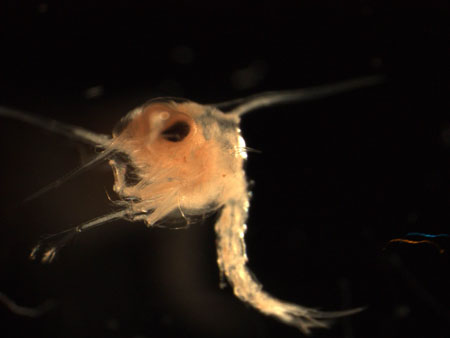Reproduction
"Let's talk about sex,
baby!"
 Males
Males
The male snow crabs go through a series of stages before they are sexually mature enough to reproduce. The first stage is called the "juvenile stage". In this stage the reproductive organs are not functionable. The next stage is called the "adolescent stage". During this stage, the reproductive organs do function but the claws are not present. The crabs cannot reproduce during this stage because they use their claws for holding the female during reproduction and they use them for fighting off other males that could interfere with their reproduction process. The final stage before the male snow crabs are completely sexually mature is called the "adult stage". This is the stage that the snow crabs reproduce in. During the "juvenile" and "adolescent" stages, the snow crab has the potential to molt every year until their claws are at their mature size. This may take anywhere from four to eleven years. After their molt into the "adult stage", they do not molt anymore during their lifetime.
 Females
Females
The female snow crabs must undergo a series of stages before they are sexually mature as well. The first stage is called the "immature stage". During this stage, the ovaries are nonexistent, and the abdomen is very narrow. The "prepubescent stage", the second stage is characterized by detectable ovaries in their early development. The final stage, known as the "adult stage" is the stage in which the female crabs are sexually mature enough to reproduce and is characterized by the widened abdomen size. The female will molt approximately eight to ten times before it reaches the adult stage. The molt into the adult stage is known as the terminal molt which means the crab will never molt again, as seen in the male crabs.
 Mating
Process
Mating
Process
The mating process in snow crabs is very competitive. The male gender will fight one another for the female snow crab of choice. This could result in several injuries including the loss of appendages.
As early as three weeks prior to mating, the male snow crab will hold onto the female snow crab. During this span, the female will undergo her final molt, in which the male will help with. After the final molt of the female, the couple of crabs will move to shallow water. This migration usually occurs during a span of February to March. Males fertilize the female's eggs prior to their release. Once the eggs are fertilized, the female will carry them on her pelopods which are located under her abdomen, where they will remain until the larva hatch. This could take up to two years!(This is all dependent upon the temperatures of the water.)
Offspring Produced
Female snow crabs can
produce upwards of 100,000 eggs each time they reproduce. This
results in a large amount of larval production. When snow crabs are in their larval stage, they look very similar to that of a
shrimp larva. They are also very vulnerable to predators and
diseases such as Bitter Crab Disease. The large numbers of
offspring produced is a direct result of overcoming these hazards,
and making sure some of the offspring survive. The larva
produced can be found at all levels of the ocean, from the surface
of the water to the bottom. The temperature of the water
determines how long the larva spends in this stage, after which it
will settle on the bottom of the ocean at its optimal depth where it
will spend the majority of its life and undergo its remaining molts.
crabs are in their larval stage, they look very similar to that of a
shrimp larva. They are also very vulnerable to predators and
diseases such as Bitter Crab Disease. The large numbers of
offspring produced is a direct result of overcoming these hazards,
and making sure some of the offspring survive. The larva
produced can be found at all levels of the ocean, from the surface
of the water to the bottom. The temperature of the water
determines how long the larva spends in this stage, after which it
will settle on the bottom of the ocean at its optimal depth where it
will spend the majority of its life and undergo its remaining molts.
To learn more about the reproduction process of snow crabs visit Fisheries and Oceans Canada.
